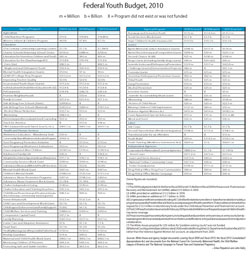|
Click Image for PDF of Chart |
A new $110 million appropriation for teen pregnancy prevention in the 2010 federal budget, along with the Obama administration’s elimination of funds for abstinence-only education, has revived the battle in Washington over where sex education funds should go.
Because the new money is expected, but not certain, to benefit organizations that run comprehensive sex education programs, abstinence-only proponents are scurrying to maintain a link to federal funding.
Two developments have significantly altered who will get the money:
1. For years, there have been two pots for abstinence education: one mandatory annual account of $50 million (Section 510 State Abstinence Education) that began in the mid-1990s; and a discretionary program for community-based abstinence education that depends on annual congressional funding. That program received nearly $100 million in fiscal 2009.
Under a Democratic Congress and White House, the mandatory program was allowed to expire in June, and no abstinence money was provided for the current year, fiscal 2010, which began Oct. 1.
2. Instead, Congress created a $110 million Teen Pregnancy Prevention Initiative (TPPI), which passed as part of the 2010 Consolidated Appropriations Act, signed by President Barack Obama in mid-December. The proposal closely follows Obama’s budget request, which called for a shift throughout his budget to programs that have been shown through evaluations to be effective. Most studies have found little evidence to support the effectiveness of abstinence-only programs.
What now?
Congressional lawmakers said $100 million of the new money should be spent on competitive grants to a range of public and private entities for evidence-based teen pregnancy prevention that is “medically accurate and age-appropriate.” They divided the grant money into two pots – $75 million to replicate rigorously evaluated programs with strong evidence of success, and $25 million for innovative strategies that may not yet have strong evaluations.
But there is little information about exactly how the U.S. Department of Health and Human Services (HHS) will roll out the new funds. HHS program rules for allocating the new dollars will be telling, because they may determine whether any of the existing community-based abstinence education grantees can reapply for a share of the $100 million when their current funds expire.
Valerie Huber, executive director of the National Abstinence Education Association, said “no one knows what the teen pregnancy prevention RFP [request for proposals] is really going to look like” until HHS shows its hand, because there are many ways to interpret the legislation. She said she is “very concerned” that “there is no priority” in the program for teaching youths to avoid sex.
“This is all more complicated than anyone would like,” said Bill Albert, chief program officer for the National Campaign to Prevent Teen and Unplanned Pregnancy, in part because Congress created a new federal Office of Adolescent Health to run the sex education programs. Lawmakers set aside about $10 million of the $110 million appropriation to create the office and to fund technical assistance, training and evaluation.
HHS is establishing the office now, spokesman Luis Rosero said by e-mail, and it will support “evidence-based models … and expand teen pregnancy prevention efforts while also addressing a broader range of adolescent health issues.”
Domestic Policy Council Director Melody Barnes has said Obama “is open to innovation, and that could include abstinence-only if there is some indication it would work.”
Politics, of course
Political considerations – with Republicans largely backing abstinence education and Democrats largely backing comprehensive sex education – are rarely far below the surface.
Ardent opponents of abstinence education are satisfied with the president’s plan. “We would have liked [the president] to have actually allocated [the $110 million] to comprehensive sex education, but teen pregnancy prevention as it has been described … [is] pretty close,” said Marcela Howell, vice president for policy and communications of Advocates for Youth.
If funding goes to schools, education and health departments and community-based organizations for evidence-based teen pregnancy programs at the school level, “we would be satisfied that those funds have moved out of the realm of ineffective abstinence-only and into the realm of, at least, effective programs,” Howell said.
Huber, of the abstinence group, called the zeroing out of the abstinence funding “inexcusable.” Abstinence-only proponents like Huber were working to get the money put back, using the health care reform bill being negotiated by the House and Senate – but that legislation was thrown into doubt when the special Senate election in Massachusetts last month was won by Republican Scott Brown, costing the Democrats their 60-seat, filibuster-proof majority in the Senate.
Albert of the National Campaign said the new approach will favor what works over ideology: “The big headline here is: For the very first time, we have a real serious federal commitment to preventing teen pregnancy by committing money to programs that have evidence of success.”































